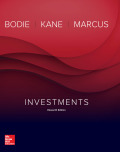
Concept explainers
A
To calculate: The expected price of the 4-year bond at the end of the first year, second year, third year and fourth year are to be determined.
Introduction: When the forward rates are equal to the market expectation rates is called as expectation hypothesis. The expected
A
Answer to Problem 8PS
The expected price of the 4-year bond is shown as −
| Beginning of the year | Expected price |
| 1 | $792.16 |
| 2 | $839.69 |
| 3 | $881.68 |
| 4 | $934.58 |
Explanation of Solution
Expectations theory is the long term interest rate that predicts the short term interest rates. It suggests the investor gets same interest by investing in two different investment having diffrent maturity period.At this condition liquidity premium is zero.
The following method will be used for the calculation of the Yield to maturity (YTM) and the forward rate −
| Maturity | Price of bond | YTM | Forward rate |
| 1 | $943.40 | ||
| 2 | $898.47 | ||
| 3 | $847.62 | ||
| 4 | $792.16 |
On calculation, the values of forward rate and YTM is given as −
| Maturity | Price of bond | YTM | Forward rate |
| 1 | $943.40 | 6.00% | 6.00% |
| 2 | $898.47 | 5.50% | 5.00% |
| 3 | $847.62 | 5.67% | 6.00% |
| 4 | $792.16 | 6.00% | 7.00% |
Now, the following method will be used for the calculation of the expected price −
| Beginning of the year | Expected price calculation | Expected price |
| 1 | $792.16 | $792.16 |
| 2 | $839.69 | |
| 3 | $881.68 | |
| 4 | $934.58 |
The expected price of the 4-year bond is given as −
| Beginning of the year | Expected price |
| 1 | $792.16 |
| 2 | $839.69 |
| 3 | $881.68 |
| 4 | $934.58 |
B
To calculate: The rate of return of the bond in first year, second year, third year and fourth year and prove that expected return equals the forward rate for each year.
Introduction: When the forward rates are equal to the market expectation rates is called as expectation hypothesis. The expected rate of return is defined as the amount which is expected on a security at specific period.
B
Answer to Problem 8PS
The forward rate and expected rate of return is equal.
Explanation of Solution
Expectations theory is the long term interest rate that predicts the short term interest rates. It suggests the investor gets same interest by investing in two different investment having diffrent maturity period. At this condition liquidity premium is zero.
The following formula will be used for the calculation of the return of year bond −
| Beginning of the year | Expected price | Expected rate of return calculation | Expected rate of return |
| 1 | $792.16 | 6.00% | |
| 2 | $839.69 | 5.00% | |
| 3 | $881.68 | 6.00% | |
| 4 | $934.58 | 7.00% |
Now, the comparison between the values of the forward rate and the expected rate of return is given as −
| Forward rate | Expected rate of return |
| 6.00% | 6.00% |
| 5.00% | 5.00% |
| 6.00% | 6.00% |
| 7.00% | 7.00% |
The above table proves that the value of the forward rate is equal to the value of the expected rate of return for each year.
Want to see more full solutions like this?
Chapter 15 Solutions
EBK INVESTMENTS
- Take value of 1.01^-36=0.699 . step by steparrow_forwardsolve this question.Pat and Chris have identical interest-bearing bank accounts that pay them $15 interest per year. Pat leaves the $15 in the account each year, while Chris takes the $15 home to a jar and never spends any of it. After five years, who has more money?arrow_forwardWhat is corporate finance? explain all thingsarrow_forward
 Intermediate Financial Management (MindTap Course...FinanceISBN:9781337395083Author:Eugene F. Brigham, Phillip R. DavesPublisher:Cengage Learning
Intermediate Financial Management (MindTap Course...FinanceISBN:9781337395083Author:Eugene F. Brigham, Phillip R. DavesPublisher:Cengage Learning Principles of Accounting Volume 1AccountingISBN:9781947172685Author:OpenStaxPublisher:OpenStax College
Principles of Accounting Volume 1AccountingISBN:9781947172685Author:OpenStaxPublisher:OpenStax College


